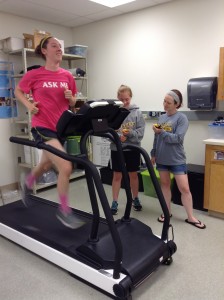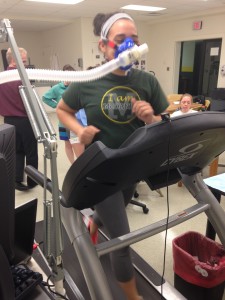During the last week in May I had the privilege of attending the annual conference of the American College of Sports Medicine (ACSM) in Orlando, Florida with Dr. McKenzie and Dr. Laird from our research team, along with my roommate for the trip, biomechanist, and avid Disney fan, Mr. Petrie. Dr. McKenzie and I presented a poster about our research from last summer. We hope everyone at the conference enjoyed their lesson about the most physiologically beneficial method for walking on an inclined treadmill. Some of the key points I learned are listed below:
- The ACSM annual meeting covers a broad range of topics and features a number of sessions on the basic sciences
- The conference itself is CRAZY with numerous sessions taking place at the same time and people dipping in and out of sessions at will.
- For better health, focus on being active, not on weight or waist circumference
- If you’re having trouble getting motivated to workout, make the activity a means to an end, rather the end itself (this includes taking stairs over elevators, standing more often, using your body as a mode of transportation- more than just your right foot, etc.)
During my week in Florida, the rest of the group faithfully finished all of the pre-testing such that we were able to stay on schedule and begin the training portion of our study this past week. For the training portion of the study, participants were matched and subsequently randomized into two different training groups operating under the following conditions:
- Standard training group- 3 min. at 60-65% maximum heart rate (max. HR), 27 min at 75-80% max. HR, 2 min. 60-65% max. HR
- High Intensity Interval Training (HIIT) group- 3 min. at 60-65% max HR followed by four bouts of alternating 4 min. at 90-95% max. HR and 3 min. at 60-65% max. HR
Both protocols are designed such that total work is the same. In both protocols, individuals arrive to the lab four times a week (Monday, Tuesday, Thursday, and Friday) to perform their training task for the day. The beauty of using heart rate to measure intensity is that it accounts for days when the participant is feeling “off” and it adjusts the intensity as fitness level increases. Already, we have noticed drastic differences in the ways that participants respond to the training load. Most of the participants in the standard training protocol appear to have adjusted fairly well; while only about half of the participants in the HIIT protocol appear to have adjusted, the other half are in visible distress throughout most of their training sessions. During one training session, a participant, having difficulty coping with the training, emphatically told me “I hate you Matt!”
Here’s to hoping we make it through another week of training visibly distressed HIIT participants.
-Matt Peterson (HIIT team)

 spend our free time pondering new studies to explore different components related to ours.
spend our free time pondering new studies to explore different components related to ours.